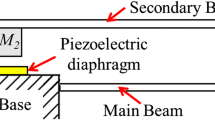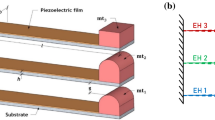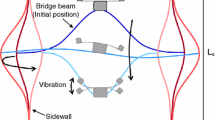Abstract
We present a human-limb driven piezoelectric energy harvester using two mass-loaded unimorph piezoelectric beams clamped on two flexible sidewalls. Since vibration generated by human-limb motion has low-frequency and high amplitude characteristics, the energy harvester has been designed to up-convert the low-frequency human-limb vibration by mechanical impact of a spring less spherical metallic ball. However, instead of direct mechanical impact on the power generating elements (unimorph piezoelectric beams), the ball impacts on the bases (flexible sidewalls) of each beam to avoid mechanical wear of the piezo-materials. While excited by human-limb motion, the ball impacts consecutively on the flexible sidewalls which transfer impulsive forces to the loaded mass of the respective unimorph beam. The beam vibrates at its own resonant frequency and causes voltage generation by virtue of piezoelectric effect. A proof-of-concept prototype has been fabricated and tested. At optimum load condition, each unimorph piezoelectric generator generates 96 µW average power while excited at 4.96 Hz frequency and ~2g acceleration. The device with series connected generators is capable of generating maximum 175 µW average power. Improved design and further optimization would be able to increase its power generation capability (as well as power density) to be used in wearable devices applications.












Similar content being viewed by others
References
Anton SR, Sodano HA (2007) A review of power harvesting using piezoelectric materials (2003–2006). Smart Mater Struct 16:R1–R21
Beeby SP, Tudor MJ, White NM (2006) Energy harvesting vibration sources for microsystems applications. Meas Sci Technol 17:R175–R195
Cartmell M (1990) Introduction to linear, parametric and nonlinear vibrations. Chapman and Hall, London
Galchev T, Kim H, Najafi K (2011) Micro power generator for harvesting low-frequency and nonperiodic vibrations. J Microelectromech Syst 20:852–866
Gu L, Livermore C (2011) Impact-driven, frequency up-converting coupled vibration energy harvesting device for low frequency operation. Smart Mater Struct 20:045004
Halim MA, Park JY (2014a) Theoretical modeling and analysis of mechanical impact driven and frequency up-converted piezoelectric energy harvester for low-frequency and wide-bandwidth operation. Sens Actuators A 208:56–65
Halim MA, Park JY (2014b) A non-resonant, frequency up-converted electromagnetic energy harvester from human-body-induced vibration for hand-held smart system applications. J Appl Phys 115:094901
Halim MA, Park JY (2015) Modeling and experiment of a handy motion driven, frequency up-converting electromagnetic energy harvester using transverse impact by spherical ball. Sens Actuators A 229:50–58
Halim MA, Cho HO, Park JY (2014) A handy-motion driven, frequency up-converted hybrid vibration energy harvester using PZT bimorph and non-magnetic ball. J Phys Conf Ser 557:012042
Halim MA, Cho H, Park JY (2015) Design and experiment of a human-limb driven, frequency up-converted electromagnetic energy harvester. Energy Convers Manag 106:393–404
Harne RL, Wang KW (2013) A review of the recent research on vibration energy harvesting via bi-stable systems. Smart Mater Struct 22:023001
Ju S, Chae SH, Choi Y, Lee S, Lee HW, Ji C-H (2013) A low frequency vibration energy harvester using magnetoelectric laminate composite. Smart Mater Struct 22:115037
Jung S-M, Yun K-S (2010) Energy-harvesting device with mechanical frequency up-conversion mechanism for increased power efficiency and wideband operation. Appl Phys Lett 96:111906
Kulah H, Najafi K (2008) Energy scavenging from low frequency vibrations by using frequency up-conversion for wireless sensor applications. IEEE Sens J 8:261–268
Mitcheson PD, Yeatman EM, Rao GK, Holmes AS, Green TC (2008) Energy harvesting from human and machine motion for wireless electronic devices. Proc IEEE 96:1457–1486
Pillatsch P, Yeatman EM, Holmes AS (2014) A piezoelectric frequency up-converting energy harvester with rotating proof mass for human body applications. Sens Actuators A 206:178–185
Pozzi M, Zhu M (2011) Plucked piezoelectric bimorphs for knee-joint energy harvesting: modeling and experimental validation. Smart Mater Struct 20:055007
Pozzi M, Aung MSH, Zhu M, Jones RK, Goulermas JY (2012) The pizzicato knee-joint energy harvester: characterization with biomechanical data and the effect of backpack load. Smart Mater Struct 21:075023
Renaud M, Fiorini P, Schaijk R, Hoof C (2009) Harvesting energy from the motion of human limbs: the design and analysis of an impact based piezoelectric generator. Smart Mater Struct 18:035001
Saadon S, Sidek O (2011) A review of vibration based MEMS piezoelectric energy harvesters. Energy Convers Manag 52:500–504
Saha CR, O’Donnell T, Wang N, McCloskey P (2008) Electro-magnetic generator for harvesting energy from human motion. Sens Actuators A 147:248–253
Thomson W (1998) Theory of vibration with applications. Prentice-Hall, New Jersey
Wei S, Hu H, He S (2013) Modeling and experimental investigation of an impact-driven piezoelectric energy harvester from human motion. Smart Mater Struct 22:105020
Williams CB, Yates RB (1996) Analysis of a micro-electric generator for microsystems. Sens Actuators A 52:8–11
Xie L, Cai M (2014) Increased piezoelectric energy harvesting from human footstep motion by using an amplification mechanism. Appl Phys Lett 105:143901
Ylli K, Hoffmann D, Willmann A, Becker P, Folkmer B, Manoli Y (2015) Energy harvesting from human motion: exploiting swing and shock excitations. Smart Mater Struct 24:025029
Zorlu O, Topal ET, Kulah H (2011) A vibration-based electromagnetic energy harvester using mechanical frequency up-conversion method. IEEE Sens J 11:481–488
Acknowledgements
The authors are grateful for receiving a research grant from Kwangwoon University in 2015 and from the Basic Science Research Program (2013R1A1A2A10064810) and the Pioneer Research Centre Program (2010-0019313) through the National Research Foundation of Korea (NRF), funded by the Ministry of Science, ICT and Future Planning of Korea.
Author information
Authors and Affiliations
Corresponding author
Rights and permissions
About this article
Cite this article
Halim, M.A., Park, J.Y. Piezoelectric energy harvester using impact-driven flexible side-walls for human-limb motion. Microsyst Technol 24, 2099–2107 (2018). https://doi.org/10.1007/s00542-016-3268-6
Received:
Accepted:
Published:
Issue Date:
DOI: https://doi.org/10.1007/s00542-016-3268-6




